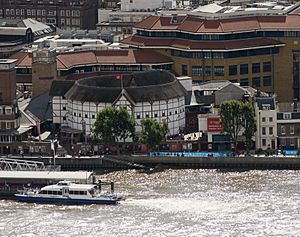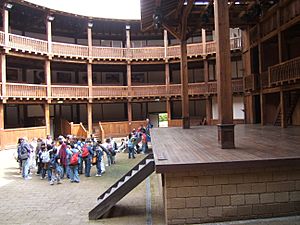Shakespeare's Globe facts for kids
|
The Globe
|
|
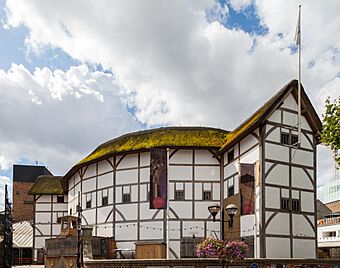
Shakespeare's Globe in August 2014
|
|
| Address | New Globe Walk London, SE1 United Kingdom |
|---|---|
| Coordinates | 51°30′29″N 0°5′50″W / 51.50806°N 0.09722°W |
| Public transit | |
| Owner | The Shakespeare Globe Trust |
| Construction | |
| Opened | June 1997 |
| Years active | 1997–present |
| Architect | Pentagram |
Shakespeare's Globe is a modern version of the famous Globe Theatre, an outdoor playhouse from the time of Queen Elizabeth I. The original theater was built in 1599, and it was where the great writer William Shakespeare presented his plays.
The new Globe is located in Southwark, London, on the south bank of the River Thames, very close to where the original once stood. It opened in 1997 and mainly shows Shakespeare's plays, but it also features other exciting shows. Next to the main theater is the Sam Wanamaker Playhouse, a smaller, indoor theater designed to feel like a playhouse from the same historical period.
Contents
History of the Globe
The Original Theatre
The first Globe Theatre was built in 1599 by Shakespeare's acting company, the Lord Chamberlain's Men. Sadly, it burned down in 1613 during a performance. It was rebuilt a year later in 1614 but was eventually torn down in 1644.
The modern Shakespeare's Globe is a careful reconstruction based on historical evidence from the 1599 and 1614 buildings. While it looks very realistic, it holds only 1,400 people for safety reasons. The original theater could pack in around 3,000 people!
The Dream of a New Globe
The idea to rebuild the Globe came from an American actor and director named Sam Wanamaker. In 1970, he started the Shakespeare Globe Trust to raise money and support for the project. He wanted to build a faithful copy of the theater near its original spot.
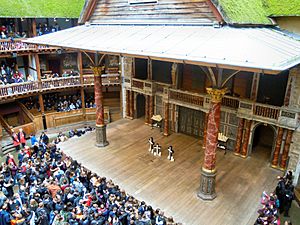
Many people thought it was impossible. They worried about matching the 16th-century design while also meeting modern fire safety rules. But Wanamaker and his team worked for over 20 years to make his dream come true. The new Globe Theatre finally opened in 1997 with a performance of Shakespeare's play Henry V.
The current artistic director is Michelle Terry. She leads the organization and decides which plays are performed.
Building the Modern Globe
A Historically Accurate Design
Wanamaker wanted the new Globe to look like the 1599 version, which was the theater Shakespeare knew best. To do this, researchers studied old drawings, descriptions, and even other buildings from that time. They also looked at the plans for a similar theater called the Fortune Playhouse.
The team of experts included architect Theo Crosby and engineer Buro Happold. They used traditional building techniques to make the theater as authentic as possible.
The theater is built from English oak wood and held together with wooden pegs, just like in the 16th century. No steel was used in the main structure. It also has the first and only thatched roof (a roof made of straw) allowed in London since the Great Fire of London in 1666. Of course, the roof is treated with fire-retardant chemicals and has sprinklers for safety.
Location and Features
The new Globe is located about 230 meters (750 feet) from the original site. The original spot is now covered by historic houses that couldn't be moved.
Like the original, the theater has a thrust stage, which sticks out into an open yard. This yard is where audience members, called "Groundlings," can stand to watch the show. Around the yard are three levels of bench seating. The only parts of the theater with a roof are the stage and the seating areas.
The theater holds about 873 people in the seats and another 700 standing in the yard. This is about half the audience of Shakespeare's time, making it a more comfortable experience.
What It's Like to See a Play
Plays are usually performed in the summer, from May to October. In the winter, the theater is used for tours and educational events.
For many years, the Globe tried to recreate the experience of watching a play in Shakespeare's time. There were no spotlights or microphones. All the music was played live on instruments from that period. This allowed the actors and the audience to see and hear each other clearly, making it feel like a shared community event.
Recently, the theater has experimented with modern lighting and sound, but the goal is still to explore the unique connection between the actors and the audience. The Globe is a popular attraction and earns all its money from ticket sales, tours, and its gift shop, without government funding.
Other Parts of the Globe Complex
Sam Wanamaker Playhouse
Right next to the Globe is the Sam Wanamaker Playhouse. It's a smaller, indoor theater that opened in 2014. It is designed to look like a playhouse from the early 1600s and is lit entirely by candles. This theater is used for performances during the winter when the main Globe is closed.
Read Not Dead
Read Not Dead is a special series of performances where actors read old plays aloud from scripts. These are plays written by other writers who lived around the same time as Shakespeare. This project helps bring forgotten plays back to life for modern audiences.
Globe Replicas Around the World
The idea of rebuilding the Globe has inspired people everywhere. Today, there are many replicas of the Globe Theatre in different countries.
- Germany: There are Globe-style theaters in Neuss, Rust, and Schwäbisch Hall.
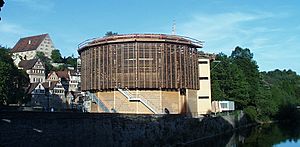
- Italy: Rome has its own Globe Theatre, built in a park called Villa Borghese.
- Japan: Tokyo is home to the Panasonic Globe Theatre.
- United States: Several cities have their own versions, including San Diego, California (Old Globe Theatre), and Cedar City, Utah (Adams Shakespearean Theatre).
- Argentina: Buenos Aires has the Teatro Shakespeare.

See also
 In Spanish: Shakespeare's Globe para niños
In Spanish: Shakespeare's Globe para niños
- Curtain Theatre
- The Rose



